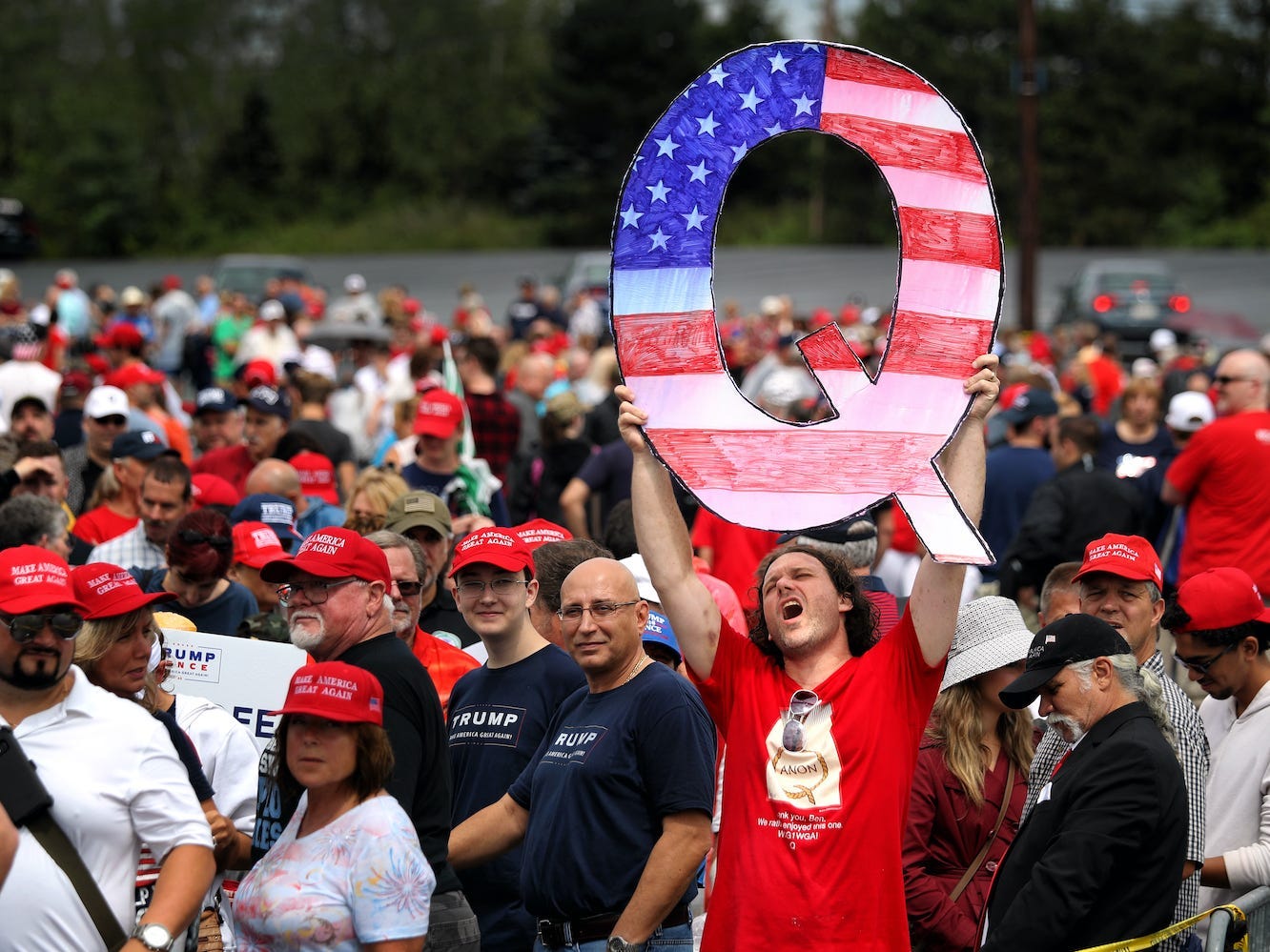
Rick Loomis/Getty Images
- The QAnon conspiracy theory was born on fringe messageboards in 2017.
- The “big-tent” theory baselessly alleges Trump has been fighting a cabal of pedophiles.
- QAnon seeped into the mainstream and became increasingly popular in 2020.
- Visit Insider’s homepage for more stories.
QAnon, the fictional right-wing conspiracy theory that alleges Trump is fighting a “deep state” cabal of human traffickers, has had a big couple weeks in Congress.
Members questioned past comments by Georgia Rep. Marjorie Taylor Greene, who has repeatedly endorsed the movement and its associated theories. Greene, who claimed last Thursday that she no longer believed in QAnon, was stripped of her congressional committee assignments on February 5.
Though Greene’s ties to QAnon were well-documented by journalists and media watchdogs alike in the months before her election to Congress, the convoluted “big tent” conspiracy theory, which is constantly spinning off new baseless allegations, has drawn recent interest in the wake of the Capitol riot. QAnon believers, along with white supremacists, diehard Trump fans, and militant gangs, stormed the Capitol to protest the election results on January 6.
The conspiracy-theory movement has been linked to several alleged and convicted violent crimes, including killings and attempted kidnappings. The first known QAnon-linked crime took place in the summer of 2018, and The movement also helped fuel the January 6 insurrection on the US Capitol.
Here’s where the conspiracy theory came from.
12th century-20th century: Blood-libel conspiracy theories
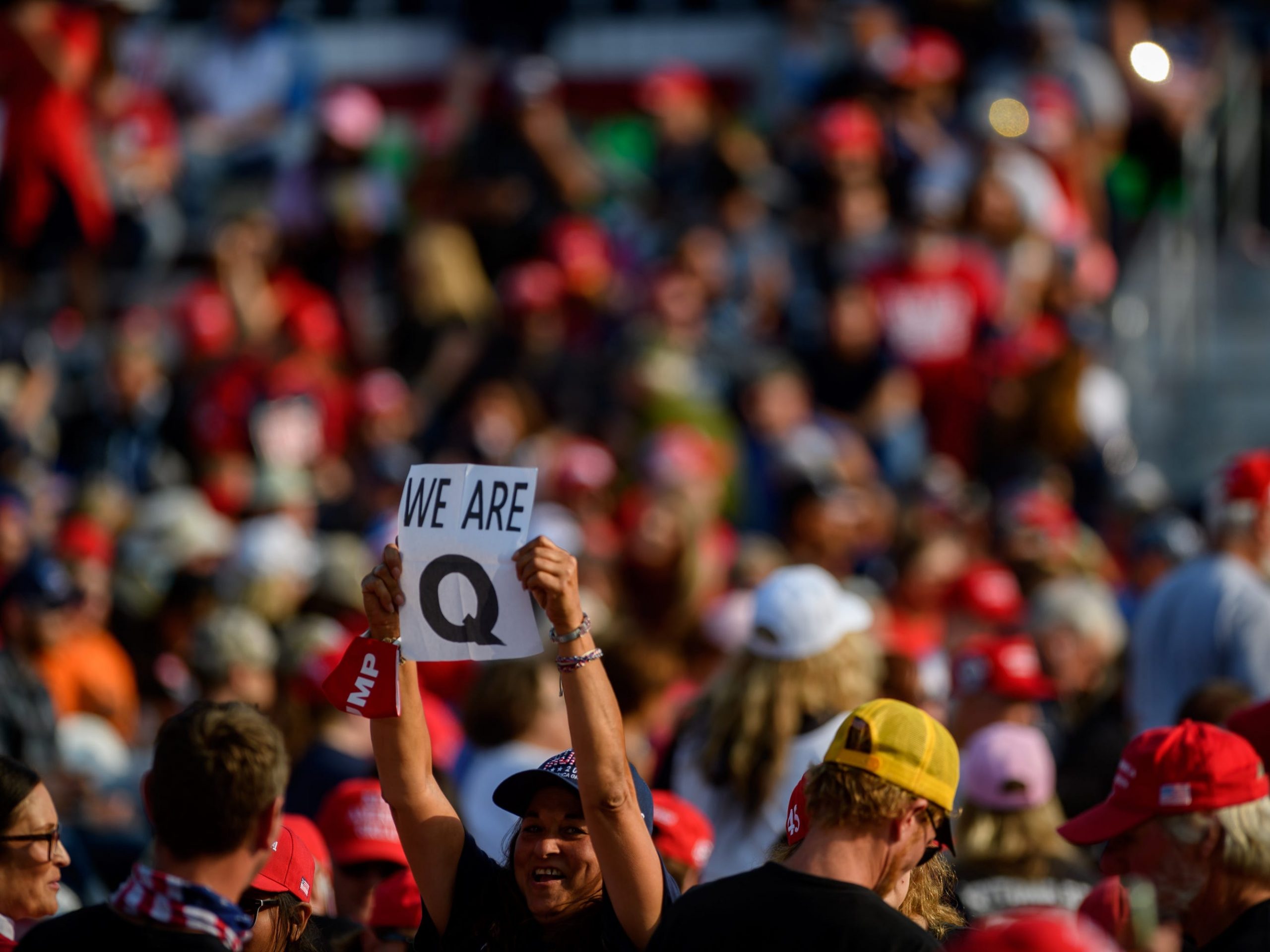
Conspiracy theories about groups of people harming children have circulated for centuries.
Anti-Semitic allegations claiming a secret cabal of Jews murdered children began spreading throughout Europe in the Middle Ages. 12th-century tropes claimed that Jews kidnapped Christian children and drank their blood to perform religious rituals.
These fictional "blood libel" stories persisted into the 20th century, according to the Anti-Defamation League. The infamous "Protocols of the Elders of Zion," a false text published in Russia in 1903, pushed the idea of "a Jewish conspiracy to dominate the world," according to the United States Holocaust Memorial Museum.
Michael Brenner, the director of American University's Center for Israel Studies and a Jewish history professor, previously told Insider that versions of these tropes "continue to exist until this very day."
QAnon folklore is based on these same tropes, including "adrenochrome," a chemical compound that conspiracy theorists claim is harvested from children and consumed by members of the fictitious cabal.
In the world of QAnon, rather than Jews writ large being accused of pedophilia and child murder, it's Democrats, "elites," and anyone else who appears to be an enemy of the movement.
October 2016: Pizzagate
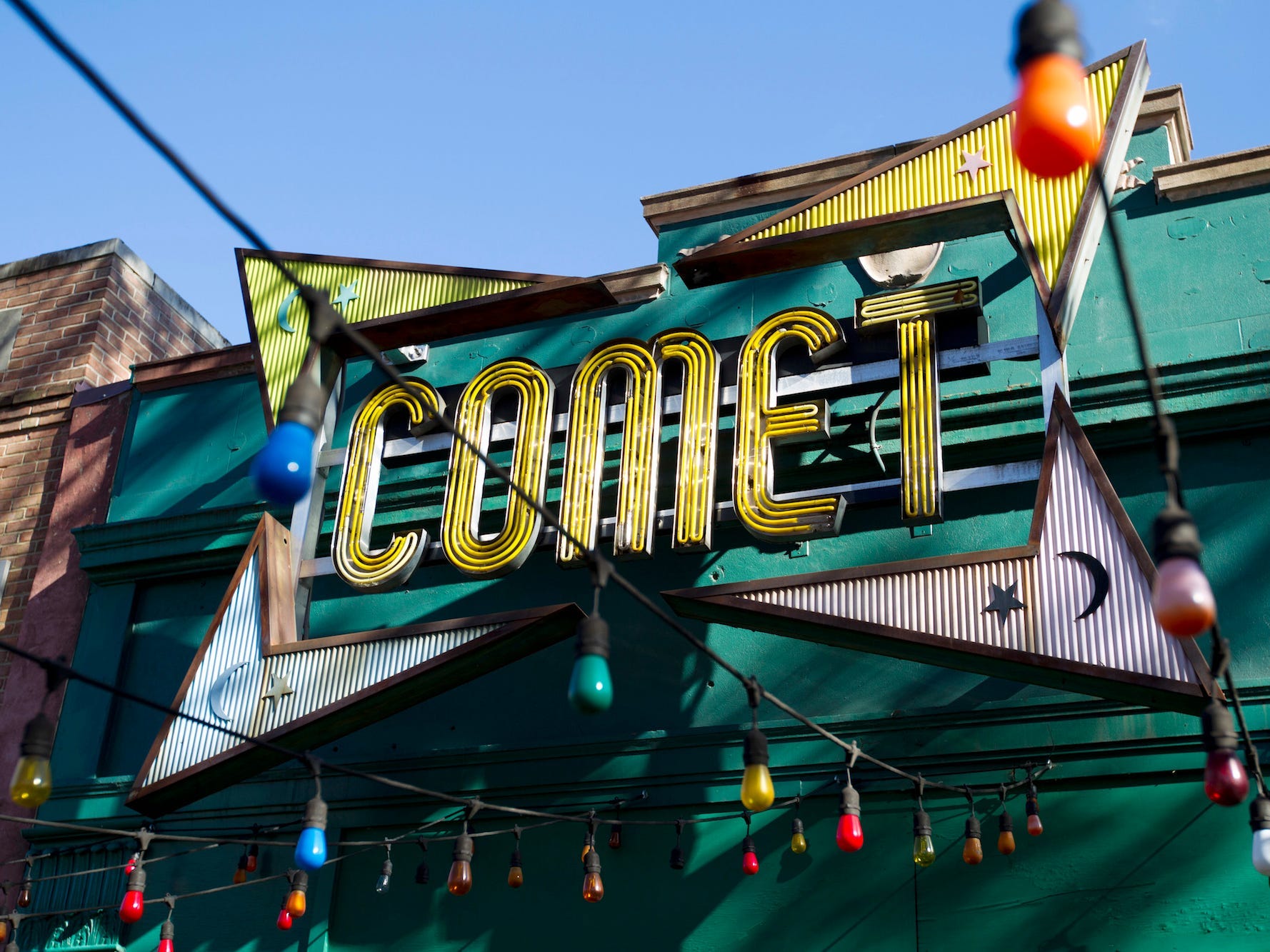
Associated Press/Jose Luis Magana
QAnon emerged in the wake of "Pizzagate," a 2016 far-right conspiracy theory that baselessly alleged Hillary Clinton and aides ran a child-trafficking ring out of a pizzeria in Washington, DC.
Murmurs of "Pizzagate," which circulated online during the 2016 election, started that October when a Twitter troll shared a screenshot of a Facebook post that falsely claimed the New York Police Department found evidence on disgraced politician Anthony Weiner's laptop that Clinton was involved in an "international child enslavement ring," as Craig Silverman of BuzzFeed News reported at the time. At the same time, conspiracy theorists on far-right message boards were discussing baseless claims that Clinton was allegedly involved in a child-trafficking scheme.
Then, a right-wing fake news article on YourNewsWire.com cited a post on 4chan, an anonymous message board that has frequently been the home of violent and racist rhetoric, claiming that emails from Clinton campaign manager John Podesta, published by WikiLeaks, used code words to discuss child trafficking. Soon, several other right-wing websites began posting similar fake news articles. As Silverman noted, that entire series of events took place in three days.
Less than two months later, Edgar Maddison Welch, who was 28 at the time, drove from North Carolina to the DC restaurant, Comet Ping Pong, where he said he believed children were being held as sex slaves. His belief was disproven after he entered the restaurant. Welch fired an assault rifle into the restaurant and was later sentenced to four years in prison on weapons charges. In an interview with The New York Times, Welch, a father of two, said he had "felt his heart breaking over the thought of innocent people suffering.'"
October 2017: The first 'Q drops'

Watkins Xerxes/YouTube
QAnon truly began on October 28, 2017, when an anonymous poster called "Q Clearance Patriot" first posted on 4chan, a message board that's frequently home to violent rhetoric. "Q," as the figure came to be known, claimed to have high-level government security clearance and referenced a cryptic impending "storm" in a thread called "Calm Before the Storm."
Weeks earlier, on October 5, President Trump told reporters, "Maybe it's the calm before the storm." A reporter asked Trump "what storm" he was talking about, and the president replied, "You'll find out." The vague comment didn't seem to reference anything at all, but on 4chan, messages from "Q" sent Trump supporters into a frenzy of theorizing.
With "Q drops," the name given to messages from the anonymous "Q" figure, the idea of this upcoming "storm" solidified into the theory of imminent public executions and arrests for child-traffickers and pedophiles. "Q's" main topics in those early days were related to Clinton's impending arrest (Clinton was never arrested), and were an offshoot of "Pizzagate." "Q drops" in the fall of 2017 also focused on George Soros, a Jewish Democratic donor who's frequently the subject of conspiracy theories, and Clinton aide Huma Abedin, as a Bellingcat investigation found.
November 2017: QAnon influencers spread the theory online
An August 2018 NBC News investigation found that three individuals - Tracy Diaz, Paul Furber, and Coleman Rogers - had been responsible for plucking "Q drops" out of obscurity and spreading them throughout the internet.
Furber and Coleman were moderators of the 4chan board that contained "Q drops," and Diaz was a far-right conspiracy-theory YouTuber. "Their goal, according to Diaz, was to build a following for Qanon - which would mean bigger followings for them as well," NBC News' Brandy Zadrozny and Ben Collins reported.
These beginnings laid the groundwork for the role influencers would play in the QAnon community. With blog posts, YouTube videos, and podcasts, QAnon influencers, including Ron Watkins, InTheMatrixxx, and ShadyGroove have become known for interpreting "Q drops."
Many popular QAnon theories were never referenced by "Q," but were spread by popular influencers in the community, including Frazzledrip, the conspiracy theory falsely alleging the existence of a video depicting Clinton and Abedin sexually abusing a child before filleting his face and wearing it as a mask. Additionally, the claim that John F. Kennedy Jr. is still alive, as well as the concept of "adrenochrome," were "brought to Q by its believers," as Mike Rothschild, a conspiracy-theory researcher who is writing a book about QAnon, said in a tweet.
January 2018: 'Q' moves to 8chan, which later becomes 8kun
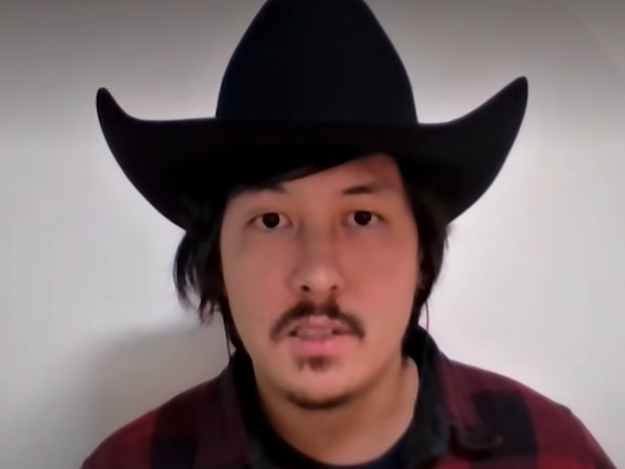
OAN/YouTube
In January 2018, "Q," identified by a unique tripcode that showed they were the same poster, moved over to the message board 8chan, which was run by Jim Watkins and his son, Ron. The platform went offline before reappearing as 8kun in 2019.
Researchers have suspected that both men could have posted as "Q" or at least have knowledge of who "Q" is. Fredrick Brennan, the software developer who created 8chan and has since become its most vocal critic, told Insider in an interview last fall that either Watkins would have had the power to fake the tripcode associated with "Q."
July 2018: QAnon paraphernalia pops up at Trump rallies
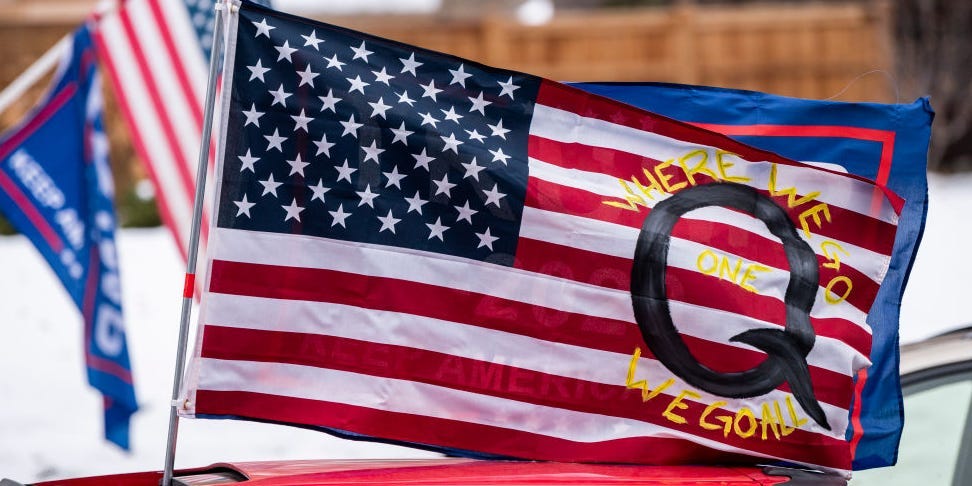
Stephen Maturen/Getty Images
In the summer of 2018, as QAnon became more popular, clothing and flags related to the conspiracy theory began popping up at Trump rallies around the country, as NPR reported. Travis View, the host of the QAnon Anonymous podcast, pointed out in a tweet at the time that several people wore "We Are Q" shirts at a July 31, 2018, rally in Tampa, Florida.
—Travis View (@travis_view) July 31, 2018
March 2020: QAnon goes mainstream with COVID-19 misinformation
While QAnon began as a fringe movement, it seeped into mainstream online spaces from 2018 to 2020.
In the beginning of 2020, when the COVID-19 pandemic began, the QAnon community played a huge role in spreading medical misinformation, which in turn helped bring more mainstream believers into the fold.
Much of the medical misinformation related to the pandemic, including false claims about the safety of wearing face masks, was popularized by the QAnon community, as a September 2020 BBC investigation found.
July 2020: 'Save the Children' and the Wayfair conspiracy theory
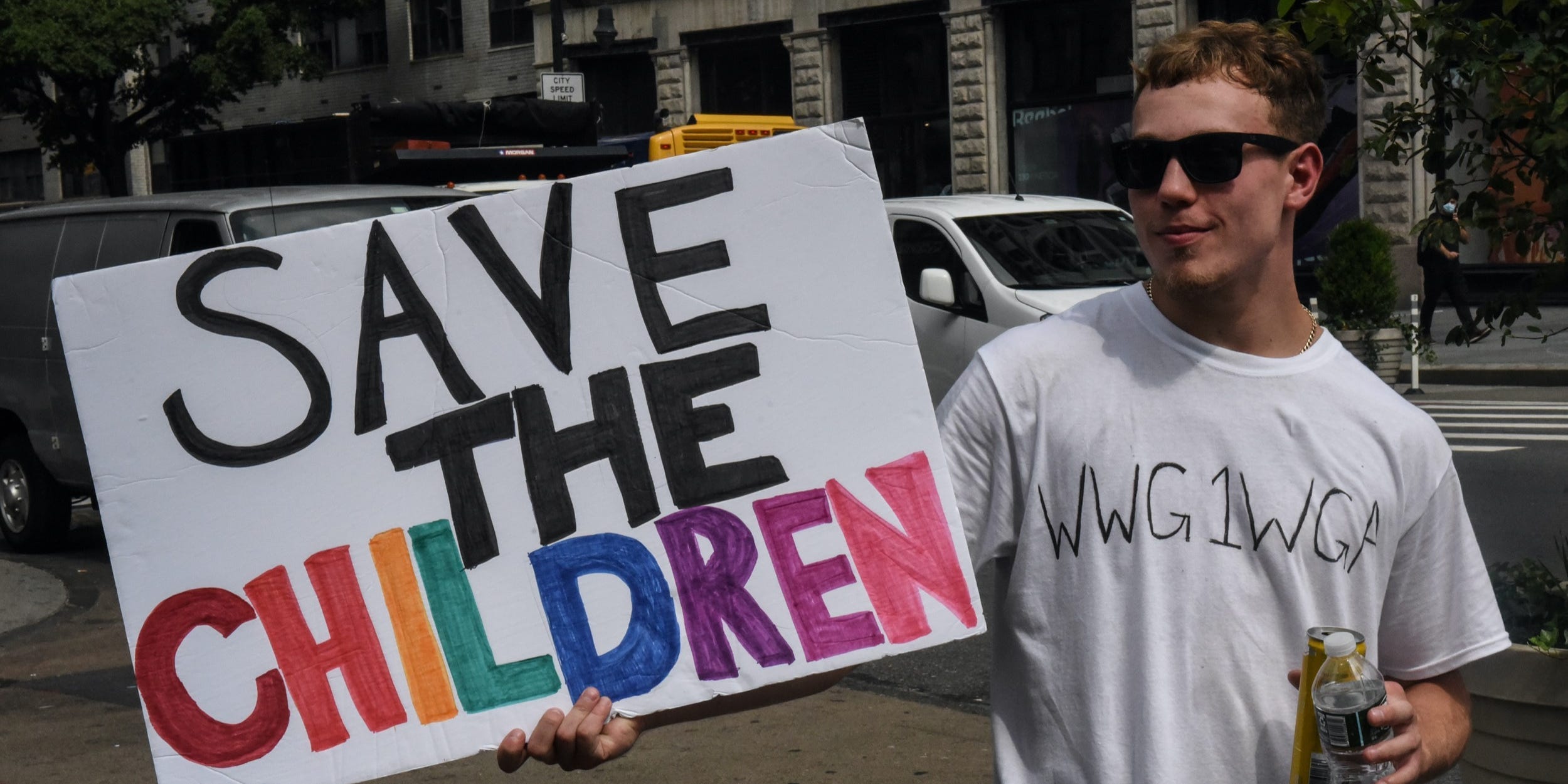
REUTERS/Stephanie Keith
In the summer of 2020, the movement pivoted its pro-Trump narrative to focus on "Save the Children," a movement that purports to seek an end to human trafficking. Actual anti-human-trafficking advocacy groups have begged QAnon believers to stop clogging their hotlines with false tips.
But with both anti-mask and anti-human-trafficking rhetoric, QAnon gained steam among "normies," in what University of Amsterdam researchers have called the "normiefication" of QAnon.
A conspiracy theory alleging the Wayfair furniture company was selling human children on its website went viral in mainstream social-media spaces like Instagram in July. The Wayfair theory was created by a QAnon influencer, Insider found.
Lifestyle influencers, mommy bloggers, and yogis began to espouse QAnon rhetoric online. This group's QAnon beliefs are more tied to the idea of a secretive, shadowy cabal than to Trump being our savior. It's this version of QAnon that's also spread to other countries, including Germany.
July-October 2020: Platforms crackdown on QAnon
In the summer of 2020, tech companies began to crack down on QAnon, which had reached millions of users in Facebook groups, an NBC News report found.
Twitter banned 7,000 QAnon-linked accounts in July 2020, beginning a wave of moderation. TikTok banned QAnon-related hashtags that month, followed by a Facebook ban in August.
In October, Twitter and Facebook increased their moderation and YouTube began cracking down on the theory.
November 2020: The movement focuses on voter-fraud claims
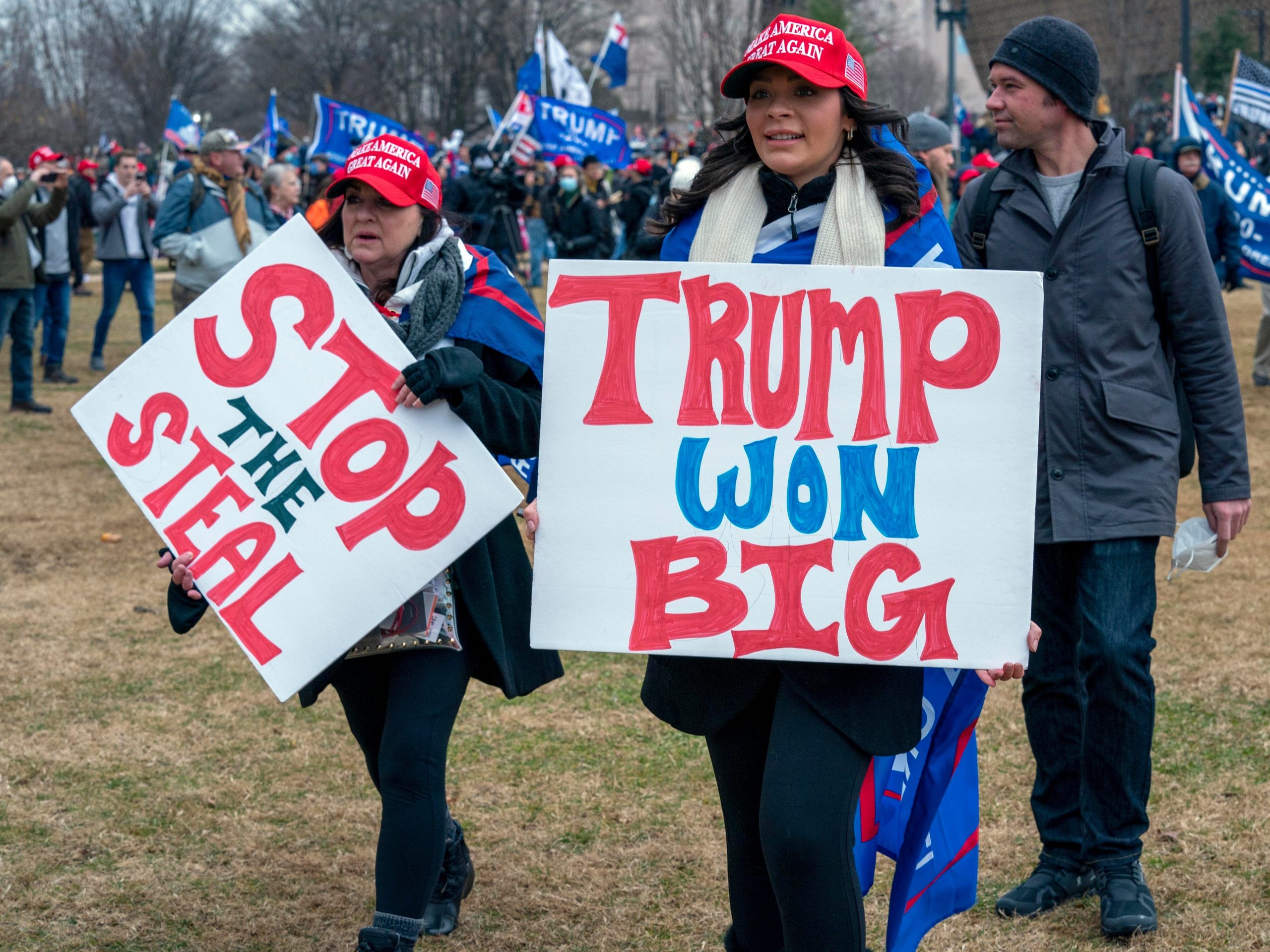
AP Photo/Jose Luis Magana
When Joe Biden won the 2020 presidential election, QAnon believers, like other communities of Trump supporters, didn't believe the results. QAnon mythology depended on Trump remaining in office for another four years, and the news that his tenure was over came as a shock.
Joining forces with the Stop the Steal movement, QAnon shifted to focus its efforts on voter-fraud allegations to discredit the election. Ron Watkins and other QAnon influencers, including the lawyers Lin Wood and Sidney Powell, popularized the conspiracy theory alleging Dominion Voting Systems had interfered in the election.
The claim is baseless, and the Cybersecurity and Infrastructure Security Agency (CISA) has said that the election was the "most secure" election in American history.
One America News Network, a pro-Trump propaganda outlet that continually spread the false claim that Trump had won the election, interviewed Watkins, claiming that he was "cyber analyst" who identified issues with Dominion's machines.
The Dominion claim became so widespread that Trump and his lawyer, Rudy Giuliani, both tweeted about it. As Ben Collins of NBC News reported, citing Advance Democracy research, 1 in 7 tweets about "#Dominion" in the weeks after the election originated from QAnon accounts.
QAnon's voter-fraud claims contributed to the frenzy that led to the US Capitol riot.
December 2020: 'Q' stops posting
While "Q drops" became less frequent over the course of 2020, they stopped altogether on December 8, after "Q" posted a since-deleted pro-Trump YouTube video.
Through the January 6 insurrection on the US Capitol, which featured many QAnon believers, and Biden's inauguration, "Q" has stayed silent.
But "Q" has become less important to the movement over the years. As Insider reported in October 2020, even finding hard proof that Jim Watkins or someone else was "Q" might not impact the movement at all.
"I think a lot of people have this fantasy that once we sort of uncover the truth to QAnon and its origins, that will somehow break the spell for the QAnon followers," View, the QAnon Anonymous host and researcher, told Insider in a previous interview. "That's just not the case."
January 2021: The Capitol riot and post-Trump QAnon
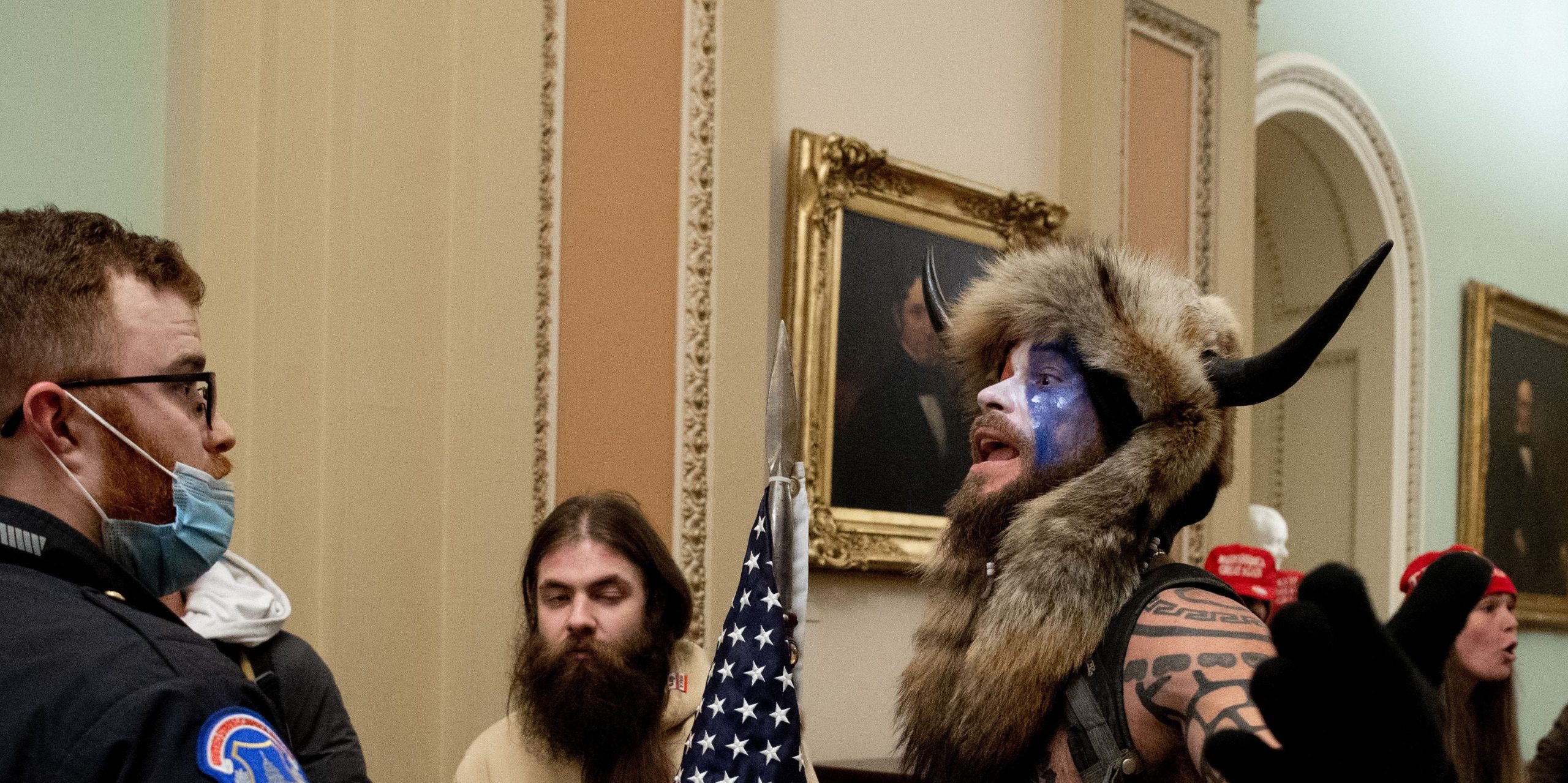
SAUL LOEB/AFP via Getty Images
On January 6, pro-Trump insurrectionists stormed the US Capitol in protest of Biden's win. The coup attempt, which occurred while Congress met to certify the Electoral College results, featured many QAnon believers, including the "Q Shaman," a popular fixture at QAnon rallies.
But much to the dismay of QAnon believers, Biden was inaugurated on January 20. Many QAnon followers began to express a loss of faith in the theory, as they thought Trump would somehow be able to remain in office. Still, the conspiracy theory has been able to shift so much that it remains hugely popular weeks after the inauguration.
February 2021: Marjorie Taylor Greene
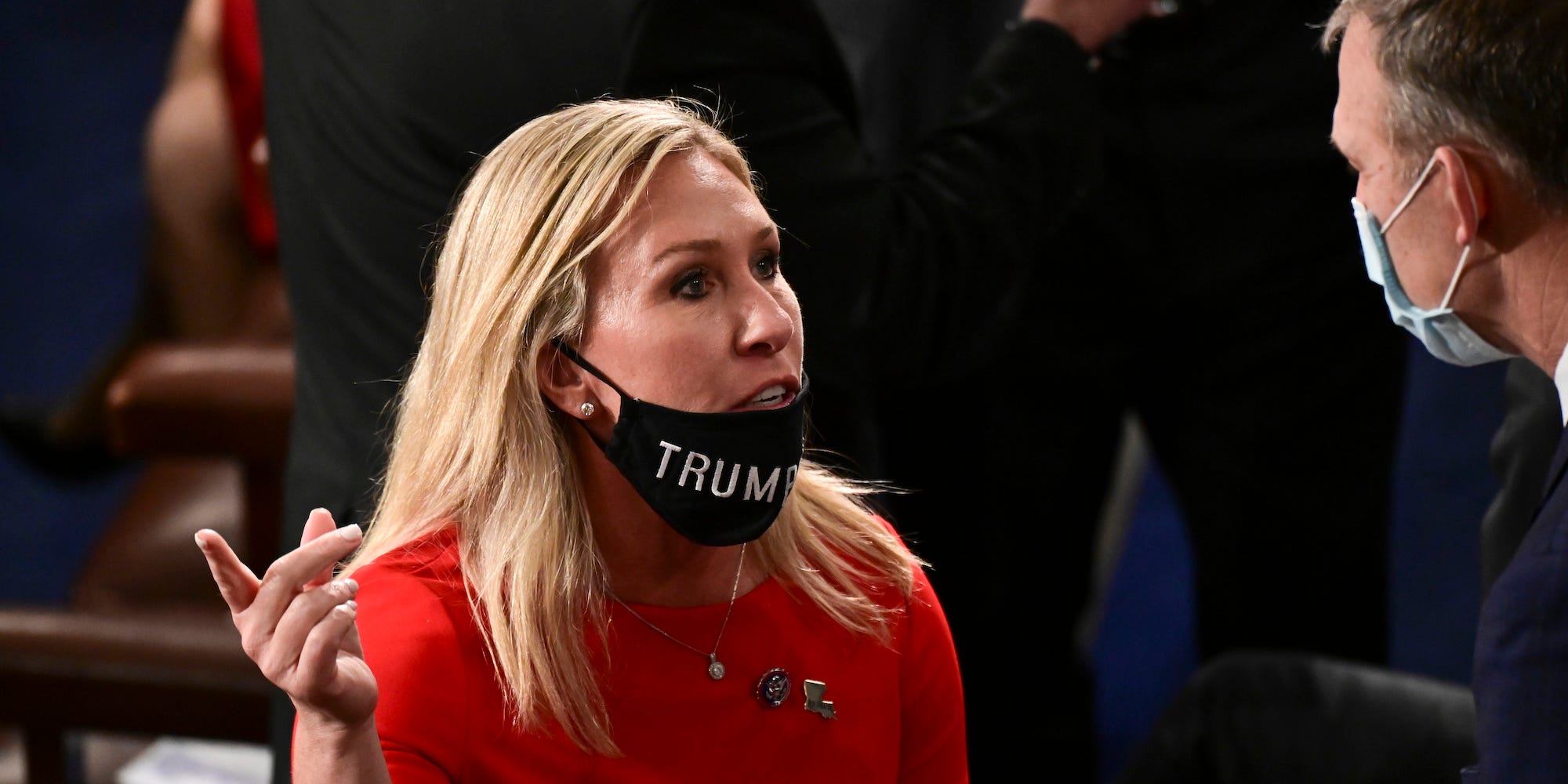
Erin Scott-Pool/Getty
Rep. Marjorie Taylor Greene, a freshman Republican from Georgia, began her first term in Congress in January. But Greene's support for the QAnon conspiracy theory, as well as other offensive claims, drew criticism in the wake of the Capitol riot. Greene claimed to disavow QAnon, but members of the House voted to remove her from her committee assignments on February 5.
